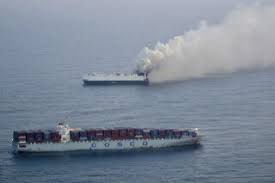Cargo ship carrying new vehicles to Mexico sinks in the North Pacific weeks after catching fire

A major maritime accident in the North Pacific has raised serious concerns about transporting electric vehicles (EVs) by sea. The cargo ship Morning Midas, carrying over 3,000 brand-new vehicles, sank on June 25, three weeks after a fire broke out onboard. The vessel was en route from Yantai, China, to Lázaro Cárdenas, Mexico, when the fire started in early June.
🔥 Fire Ignites Mid-Voyage
On June 3, 2025, the ship was sailing 300 miles southwest of Adak Island in Alaska when the crew discovered the fire. The crew tried to control it, but heavy smoke and heat forced them to evacuate. All 22 members escaped safely in lifeboats and were rescued by the merchant ship Cosco Hellas. The U.S. Coast Guard confirmed there were no injuries.
The vessel remained adrift, still burning. Fire crews couldn’t reach it right away due to the remote location and unstable conditions.
🚨 Salvage Efforts Couldn’t Save the Ship
A salvage team arrived days later and tried to suppress the fire. However, the fire had already caused major structural damage. The ship also started taking on water due to rough sea conditions. These factors led to its sinking on June 25, about 415 miles off Alaska’s coast.
The Morning Midas now lies roughly 16,400 feet (5,000 meters) below sea level.
🌊 Environmental Risks Under Watch
The ship carried large amounts of fuel and over 800 electric vehicles. Lithium-ion batteries are known to be hazardous if damaged or submerged. Despite this, the Coast Guard reported no immediate pollution after the ship went down. Pollution-response tugs remain in the area to track and manage any future leaks or surface debris.
Experts are still monitoring the site, especially since deep-sea contamination can take time to emerge. So far, the sea around the wreck appears clean.
🚗 Cargo Details
The Morning Midas was transporting more than 3,000 vehicles, including EVs from Chinese manufacturers. Industry sources say about 800 of these vehicles were electric. Most EVs use lithium-ion batteries, which pose a fire risk if not stored and managed properly.
Reports suggest the fire may have started in one of the EVs, but authorities haven’t confirmed the cause. Investigators will review all onboard systems, cargo logs, and safety protocols to learn what went wrong.
The financial loss is significant. The vehicles alone were worth millions of dollars. Automakers and insurers will likely face delays and high replacement costs.
⚠️ The Challenge of EV Fires at Sea
EV fires present unique risks, especially on ships. Lithium-ion batteries can overheat and enter a “thermal runaway,” a reaction that creates intense heat and can cause nearby batteries to ignite. Once that starts, standard firefighting systems struggle to contain the blaze.
Most ships lack the tools to deal with battery fires. Foam and water often can’t cool the batteries enough to stop the reaction. In some cases, EVs reignite hours or days after appearing to go out.
Shipping experts say vessels carrying EVs need advanced fire detection systems and specialized extinguishers. Many are calling for urgent safety upgrades across the maritime industry.
⛴️ Similar Disasters Raise Red Flags
This isn’t the first case of an EV fire causing a ship to sink. In 2022, the Felicity Ace burned for days in the Atlantic before it sank with nearly 4,000 vehicles onboard. That ship also carried several electric models.
In 2023, a Japanese cargo ship had to anchor after crew detected smoke coming from its EV cargo. Luckily, that fire was caught early and extinguished before serious damage occurred.
The Morning Midas incident fits a pattern that regulators can no longer ignore.
📉 Industry Reactions
Insurers and maritime regulators are taking notice. Some insurers have already raised premiums for EV shipments or restricted the number of electric cars allowed on each voyage.
Maritime safety experts argue that the industry must adapt. Ships that transport electric vehicles need updated cargo storage rules, fireproof compartments, and emergency training for EV fires.
The International Maritime Organization (IMO) is now reviewing safety protocols. They may propose new guidelines to address the rising risks of EV transport at sea.
🔍 Investigation Underway
A full investigation is now in progress. Experts will examine the fire’s point of origin and whether faulty batteries or poor cargo handling caused it. They will also review how long the fire burned, what materials it affected, and why suppression efforts failed.
Initial findings may take weeks, but a full report will likely take several months.
Meanwhile, environmental teams are watching the wreck for leaks or debris. So far, no oil slick or battery contamination has appeared on the surface. That could change as the wreck ages and pressure impacts the submerged materials.
🔄 Future of EV Shipping in Question
This sinking raises important questions about how safe the current shipping system is for EVs. The demand for electric vehicles is rising, and automakers rely on ships to reach global markets. But as battery sizes grow and volumes increase, so do the risks.
Governments and companies must now ask: Are our ships ready for this new era of cargo?
Many in the industry believe they aren’t. Without major upgrades, more accidents may follow.
📝 Final Thoughts
The Morning Midas tragedy is more than a shipping loss. It’s a warning about the future of global trade. As the world shifts toward clean energy and battery power, we must also build safe, fire-resistant systems to move these technologies across oceans.
EVs may be the future, but their transport must not threaten lives or the environment. It’s time for shipping to evolve.nsition is accelerating, ensuring the safe, secure, and environmentally sound transport of EVs must now become a top global priority.






